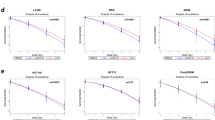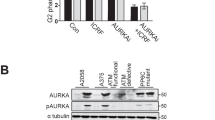Abstract
The vast majority of cancer cells have defective checkpoints that permit the cell cycle to progress in the presence of double-strand DNA breaks (DSBs) caused by ionizing radiation (IR) and radiomimetic drugs. ATR (ataxia telangiectasia-mutated and Rad3-related) has recently been shown to be activated by DSBs, although the consequences of this activity are largely unknown. In this report, we use advanced gene targeting methods to generate biallelic hypomorphic ATR mutations in human colorectal cancer cells and demonstrate that progression of the cancer cell cycle after IR treatment requires ATR. Cells with mutant ATR accumulated at a defined point at the beginning of the S phase after IR treatment and were unable to progress beyond that point, whereas cells at later stages of the S phase during the time of irradiation progressed and completed DNA replication. The prolonged arrest of ATR mutant cancer cells did not involve the ataxia telangiectasia mutated-dependent S-phase checkpoint, but rather closely resembled a previously characterized form of cell cycle arrest termed S-phase stasis. As ATR strongly contributed to clonogenic survival after IR treatment, these data suggest that blocking ATR activity might be a useful strategy for inducing S-phase stasis and promoting the radiosensitization of checkpoint-deficient cancer cells.
This is a preview of subscription content, access via your institution
Access options
Subscribe to this journal
Receive 50 print issues and online access
$259.00 per year
only $5.18 per issue
Buy this article
- Purchase on Springer Link
- Instant access to full article PDF
Prices may be subject to local taxes which are calculated during checkout





Similar content being viewed by others
References
Abraham RT . (2001). Cell cycle checkpoint signaling through the ATM and ATR kinases. Genes Dev 15: 2177–2296.
Adams KE, Medhurst AL, Dart DA, Lakin ND . (2006). Recruitment of ATR to sites of ionising radiation-induced DNA damage requires ATM and components of the MRN protein complex. Oncogene 25: 3894–3904.
Alderton GK, Joenje H, Varon R, Borglum AD, Jeggo PA, O'Driscoll M . (2004). Seckel syndrome exhibits cellular features demonstrating defects in the ATR-signalling pathway. Hum Mol Genet 13: 3127–3138.
Bernardi R, Liebermann DA, Hoffman B . (2000). Cdc25A stability is controlled by the ubiquitin–proteasome pathway during cell cycle progression and terminal differentiation. Oncogene 19: 2447–2454.
Borel F, Lacroix FB, Margolis RL . (2002). Prolonged arrest of mammalian cells at the G1/S boundary results in permanent S phase stasis. J Cell Sci 115: 2829–2838.
Brown EJ, Baltimore D . (2000). ATR disruption leads to chromosomal fragmentation and early embryonic lethality. Genes Dev 14: 397–402.
Brown EJ, Baltimore D . (2003). Essential and dispensable roles of ATR in cell cycle arrest and genome maintenance. Genes Dev 17: 615–628.
Bunz F, Dutriaux A, Lengauer C, Waldman T, Zhou S, Brown JP et al. (1998). Requirement for p53 and p21 to sustain G2 arrest after DNA damage. Science 282: 1497–1501.
Cha RS, Kleckner N . (2002). ATR homolog Mec1 promotes fork progression, thus averting breaks in replication slow zones. Science 297: 602–606.
Cliby WA, Roberts CJ, Cimprich KA, Stringer CM, Lamb JR, Schreiber SL et al. (1998). Overexpression of a kinase-inactive ATR protein causes sensitivity to DNA-damaging agents and defects in cell cycle checkpoints. EMBO J 17: 159–169.
Cortez D, Guntuku S, Qin J, Elledge SJ . (2001). ATR and ATRIP: partners in checkpoint signaling. Science 294: 1713–1716.
Cuadrado M, Martinez-Pastor B, Murga M, Toledo LI, Gutierrez-Martinez P, Lopez E et al. (2006). ATM regulates ATR chromatin loading in response to DNA double-strand breaks. J Exp Med 203: 297–303.
Donzelli M, Draetta GF . (2003). Regulating mammalian checkpoints through CDc25 inactivation. EMBO Rep 4: 671–677.
Falck J, Lukas C, Protopopova M, Lukas J, Selivanova G, Bartek J . (2001a). Functional impact of concomitant versus alternative defects in the Chk2–p53 tumour suppressor pathway. Oncogene 20: 5503–5510.
Falck J, Mailand N, Syljuasen RG, Bartek J, Lukas J . (2001b). The ATM–Chk2–Cdc25A checkpoint pathway guards against radioresistant DNA synthesis. Nature 410: 842–887.
Hirao A, Cheung A, Duncan G, Girard PM, Elia AJ, Wakeham A et al. (2002). Chk2 is a tumor suppressor that regulates apoptosis in both an ataxia telangiectasia (ATM)-dependent and an ATM-independent manner. Mol Cell Biol 22: 6521–6532.
Jazayeri A, Falck J, Lukas C, Bartek J, Smith GC, Lukas J et al. (2006). ATM- and cell cycle dependent regulation of ATR in response to DNA double-strand breaks. Nat Cell Biol 8: 37–45.
Jirmanova L, Bulavin DV, Fornace Jr AJ . (2005). Inhibition of the ATR/Chk1 pathway induces a p38-dependent S-phase delay in mouse embryonic stem cells. Cell Cycle 4: 1428–1434.
Kastan MB, Bartek J . (2004). Cell-cycle checkpoints and cancer. Nature 432: 316–323.
Kastan MB, Lim DS . (2000). The many substrates and functions of ATM. Nat Rev Mol Cell Biol 1: 179–186.
Kumar S, Huberman JA . (2004). On the slowing of S phase in response to DNA damage in fission yeast. J Biol Chem 279: 43574–43580.
Mailand N, Falck J, Lukas C, Syljuasen RG, Welcker M, Bartek J et al. (2000). Rapid destruction of human Cdc25A in response to DNA damage. Science 288: 1425–1429.
McGowan CH, Russell P . (2004). The DNA damage response: sensing and signaling. Curr Opin Cell Biol 16: 629–633.
Myers JS, Cortez D . (2006). Rapid activation of ATR by ionizing radiation requires ATM and Mre11. J Biol Chem 281: 9346–9350.
O'Connor PM, Jackman J, Bae I, Myers TG, Fan S, Mutoh M et al. (1997). Characterization of the p53 tumor suppressor pathway in cell lines of the National Cancer Institute anticancer drug screen and correlations with the growth-inhibitory potency of 123 anticancer agents. Cancer Res 57: 4285–4300.
O'Driscoll M, Gennery AR, Seidel J, Concannon P, Jeggo PA . (2004). An overview of three new disorders associated with genetic instability: LIG4 syndrome, RS-SCID and ATR-Seckel syndrome. DNA Repair (Amsterdam) 3: 1227–1235.
O'Driscoll M, Ruiz-Perez VL, Woods CG, Jeggo PA, Goodship JA . (2003). A splicing mutation affecting expression of ataxia-telangiectasia and Rad3-related protein (ATR) results in Seckel syndrome. Nat Genet 33: 497–501.
Osborn AJ, Elledge SJ, Zou L . (2002). Checking on the fork: the DNA-replication stress-response pathway. Trends Cell Biol 12: 509–516.
Painter RB, Young BR . (1980). Radiosensitivity in ataxia-telangiectasia: a new explanation. Proc Natl Acad Sci USA 77: 7315–7737.
Saleh-Gohari N, Bryant HE, Schultz N, Parker KM, Cassel TN, Helleday T . (2005). Spontaneous homologous recombination is induced by collapsed replication forks that are caused by endogenous DAN single-strand breaks. Mol Cell Biol 25: 7158–7169.
Sanchez Y, Wong C, Thoma RS, Richman R, Wu Z, Piwnica-Worms H et al. (1997). Conservation of the Chk1 checkpoint pathway in mammals: linkage of DNA damage to Cdk regulation through Cdc25. Science 277: 1497–1501.
Seckel HPG . (1960). Bird-headed Dwarfs: Studies in Developmental Anthropology Including Human Proportions. Charles C Thomas: Springfield, III.
Shechter D, Costanzo V, Gautier J . (2004). ATR and ATM regulate the timing of DNA replication origin firing. Nat Cell Biol 6: 648–655.
Sorensen CS, Syljuasen RG, Falck J, Schroeder T, Ronnstrand L, Khanna KK et al. (2003). Chk1 regulates the S phase checkpoint by coupling the physiological turnover and ionizing radiation-induced accelerated proteolysis of Cdc25A. Cancer Cell 3: 247–258.
Syljuasen RG, Sorensen CS, Hansen LT, Fugger K, Lundin C, Johansson F et al. (2005). Inhibition of human Chk1 causes increased initiation of DNA replication, phosphorylation of ATR targets, and DNA breakage. Mol Cell Biol 25: 3553–3562.
Topaloglu O, Hurley PJ, Yildirim O, Civin CI, Bunz F . (2005). Improved methods for the generation of human gene knockout and knockin cell lines. Nucleic Acids Res 33: e158.
Zhao H, Piwnica-Worms H . (2001). ATR-mediated checkpoint pathways regulate phosphorylation and activation of human Chk1. Mol Cell Biol 21: 4129–4439.
Zhou BB, Elledge SJ . (2000). The DNA damage response: putting checkpoints in perspective. Nature 408: 433–449.
Acknowledgements
We thank Mr Travis Hauguel for technical assistance and Leslie Meszler of the Johns Hopkins Cell Imaging Core facility for assistance with flow cytometry. This work was supported by the Flight Attendant Medical Research Institute, the Breast Cancer Research Foundation and the National Cancer Institute (R01CA104253) to FB.
Author information
Authors and Affiliations
Corresponding author
Rights and permissions
About this article
Cite this article
Hurley, P., Wilsker, D. & Bunz, F. Human cancer cells require ATR for cell cycle progression following exposure to ionizing radiation. Oncogene 26, 2535–2542 (2007). https://doi.org/10.1038/sj.onc.1210049
Received:
Revised:
Accepted:
Published:
Issue Date:
DOI: https://doi.org/10.1038/sj.onc.1210049
Keywords
This article is cited by
-
Targeting radiation-resistant hypoxic tumour cells through ATR inhibition
British Journal of Cancer (2012)
-
ATR mediates cisplatin resistance in a p53 genotype-specific manner
Oncogene (2011)
-
AAV-mediated gene targeting methods for human cells
Nature Protocols (2011)
-
Genetic knockouts and knockins in human somatic cells
Nature Protocols (2007)
-
Emerging links between the biological clock and the DNA damage response
Chromosoma (2007)



